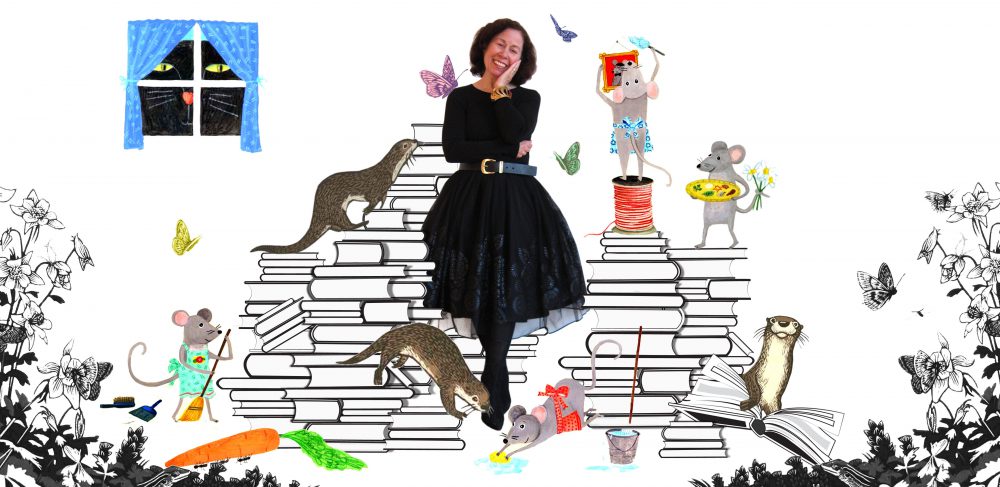WILL WRITE FOR COOKIES
INSIGHT – INFORMATION – INSPIRATION FOR WRITERS
TODAY’S GUEST
EMMA WALTON HAMILTON
We are so very lucky! Our guest today is one of those rare people who has attained success and then is anxious to reach out and generously help mentor others.
EMMA WALTON HAMILTON is a New York Times bestselling children’s book author, editor and educator, and the host of the Children’s Book Hub. She has co-authored 20 children’s books with her mother, Julie Andrews, including THE VERY FAIRY PRINCESS (#1 NY Times bestseller), JULIE ANDREWS’ COLLECTION OF POEMS, SONGS AND LULLABIES (illustrated by James McMullan) and the DUMPY THE DUMP TRUCK series of picture books and board books and her own award-winning book, RAISING BOOKWORMS.
She offers unique resources for children’s book authors, including editorial services, workshops and courses and an online writers salon. Emma has graciously given her time and expertise to the 12×12 community with her query critique sessions…she definitely knows how to make your query sing. I’m thrilled to have her join us here.
Thank you so much for participating, Emma. I know everyone is excited to greet you!
We talk about how important books are for young kids. Who were your favorite authors/illustrators when you were a child?
So many! And this list will date me, of course… but, in no particular order:
Dr. Seuss, Marguerite Henry, Enid Blyton, Beatrix Potter, Roald Dahl, Mary Norton, Beverly Cleary, E.B. White, A.A. Milne, C.S. Lewis, Mark Twain, Laura Ingalls Wilder, Gerald Durrell, Madeleine L’Engle.
Other books I loved – The Secret Garden, The Wind in the Willows, Anne of Green Gables, Watership Down, The Black Stallion, Pippi Longstocking, the Nancy Drew books and, probably my all time favorite, The Phantom Tollbooth. That was my rainy-day book, and it taught me how delicious – and powerful – words could be.
What do you know now that you wish you had known when you first started writing for children?
How hard it is to do well – and how important it is to assess (and re-assess!) every single word for its right to exist on the page. Writing for children and young adults is so much harder than it seems. We have to be masters of economy and action. The kinds of indulgences one can get away with in adult fiction (lots of exposition, for instance) can kill a children’s book. Kids are much tougher critics than adults – adults may stick with something that’s slow to get going, for instance, but kids have so many other potential distractions and sources of entertainment. We have to grab them completely and keep them engaged, or they’ll drop a book like a hot potato and never pick it up again.
We also can’t rely on what we were like, or what we knew, or read, as kids… because kids today have such different lives and influences than we did. They can smell an adult narrator in kids clothing from a mile away. It’s important to stay current – to spend time with kids of the age that we write for, and to read everything we can, especially in our genre.
Most of all, I wish I’d known how much support is out there – from SCBWI to conferences, forums, writing groups, etc. The children’s publishing community is so embracing – much more so than adult publishing, or any other realm of the arts, I think.
We all have our favorite places to think/create/write. Where do you like to write/draw – inside, outside, a special area in your home, on the computer, in a notebook?
I have a lovely office/writing studio on the second floor of our home (a friend calls it an ‘atelier,’ which I love). It has windows on three sides and a view of the garden; it’s like being in a tree-house. The walls are lined with shelves overflowing with books – children’s books, poetry, books on writing, you name it – and I have a big oak desk with an iMac and an ergonomic chair. Where do I end up doing most of my writing? On my laptop at the kitchen table, with my kids nearby and the dog at my feet and the chaos of life all around me!
When during the day (or night) are you most productive? Do you set a schedule for working or do you write/draw when the muse speaks?
Whenever possible! Because I work so many different jobs (teaching children’s lit for Stony Brook Southampton’s Creative Writing MFA and directing their Children’s Lit Fellows program, as well their Young Artists and Writers Program in the schools, plus being a freelance editor, host of the Children’s Book Hub, and co-author/editorial director for the books my mother and I collaborate on – not to mention being a Mom with two kids and a husband and a dog etc. etc!), I grab the time whenever and wherever I can.
The saving grace is that writing with a partner means we have to schedule time to work together. That’s probably the main reason we’re able to be productive at all, otherwise I fear the writing would always be the last thing I would get to in a day…
Why do you write for children?
I love kids. My own, and everyone else’s. Becoming a mother was a watershed moment for me. It was as if I suddenly woke up and noticed the beauty, the innocence, the vulnerability, not just of my own children, but children everywhere. Let’s face it, it’s hard growing up. The world is more scary and chaotic than ever. When I was a kid, books were an oasis; a place where I could find friends, coping tools, knowledge, escape. I think they’re no less valuable today, and in some ways even more so. Good children’s books provide kids with safe opportunities to solve problems, exorcize fears, laugh at themselves, and grow. One editor I know likens them to “survival kits” for kids. I love that! If something I write can make one child smile, make one kid’s day easier or more enjoyable, I’ve lived a purposeful life.
Finally, what I love most about children’s books is that no matter how dark the subjects they tackle may be, they are ultimately, inherently, hopeful. That makes them a pleasure to write, and they just might help kids grow into thoughtful, compassionate, contributive citizens of the future. (OK – what did you expect from Mary Poppins’ daughter? J)
Some tips for today’s children’s book writers…
1) Read. I was fortunate to take a workshop once with the great poet Billy Collins. He spoke about poetry as being an ongoing “conversation” between poets across the centuries. He said every aspiring writer should first “listen to the conversation” (i.e. read as much as possible), and then, figure out what they might contribute to it. The idea of written work as part of an ongoing dialogue between writers across history really stuck with me. It’s also the best way to learn the craft – what works and what doesn’t, what’s been done, what’s possible, what makes good writing. And, it’s the best way to keep your finger on the pulse of what the market is like today, and to stay plugged in as publishing evolves – which it’s doing like crazy at the moment. Children’s books today are nothing like they were ten years ago, or even ten years before that. Read everything you can, and stay current.
2) Keep honing your craft. Take classes and workshops, attend conferences, participate in writing groups. Keep stretching, learning, sharpening your skills – even (or maybe especially) after you’ve sold your first manuscript. I actually offer an assortment of home study courses in writing children’s books, in addition to the ones I teach at the university… you can find out more here:
- www.justwritechildrensbooks.com.
- Children’s Lit Fellows – a one-year graduate level certificate program
- Southampton Children’s Lit Conference – five-day conference every July at Stony Brook Southampton.
3) Find community. Writing can be a solitary business. I’m lucky – I write with a partner and work for a graduate writing program, but it’s really important to find your tribe and connect with them regularly. Find a supportive critique group, join forums, take classes, attend conferences, whatever it takes to connect with other writers. It will keep you sane, and honest. Some of the communities I belong to include SCBWI, Julie Hedlund’s 12X12, WriteforKids.org and of course, my own Children’s Book Hub. I also participate in efforts like PiBoIdMo and WriteonCon whenever possible. There’s so much support out there!
4) Diversify your strengths. It’s the rare writer that makes a living solely from writing. Even the most successful writers in the world usually have to supplement their income with things like teaching, editing, or speaking engagements. Find ways to support your writing habit. Be willing to have a day job, to do whatever it takes… but whenever possible, try to make those other sources of income writing-related, such as through freelance writing, editing, or teaching.
Very Fairy Princess Cookies (what else?)
Ingredients:
½ cup butter, softened
¾ cup sugar
1 egg
1 teaspoon vanilla extract
2 cups all-purpose flour
½ teaspoon baking soda
½ teaspoon salt
Crown-shaped cookie cutter
Pink sugar crystals
Silver decorating balls
Instructions:
Preheat oven to 375 degrees (190 degrees C).
In a large mixing bowl, beat together sugar and butter until light and fluffy. Add egg, and vanilla extract, and beat again.
Combine flour, soda and salt in a separate bowl. Gradually add to creamy mixture and blend well.
Flatten dough to about 1/4 inch thick, cover with plastic wrap and chill in freezer for 15 minutes.
Divide dough in half. On a lightly floured work area (I love Roul’pat mats), roll each piece to 1/8 inch thick. Cut out cookies with crown shaped cutter and sprinkle with pink sugar crystals. Press silver decorating balls in a row along the bottom of each crown and in each point at the top.
Place cookies one inch apart on cookie sheets sprayed with non-stick cooking spray. Bake for 8-10 minutes or until golden. Let stand on cookie sheet for two minutes before removing to cool on wire racks.
Makes 12 4-inch cookies
Those look absolutely DELICIOUS! Thank you so much, Emma…your post was a treat in so many ways! I urge everyone to check out The Children’s Book Hub and Emma’s wonderful online book writing courses, Just Write 4 Kids. To connect with Emma:







Pingback: Katharine Holabird – Will Write for Cookies | Picture Books Help Kids Soar
Pingback: Happy New Year: Looking Back and Moving Forward | Picture Books Help Kids Soar